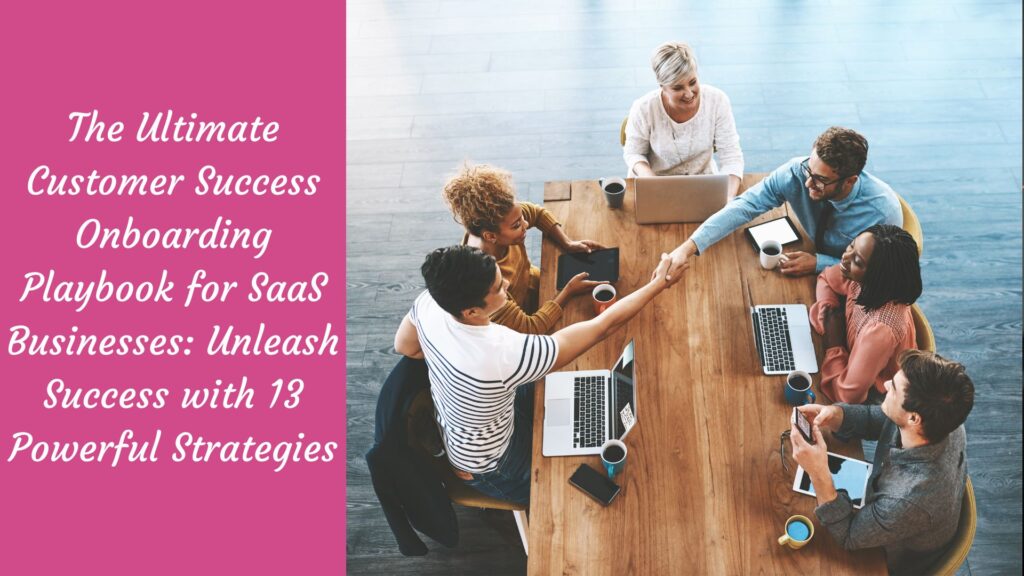Running a SaaS business comes with its fair share of challenges. One of the most crucial?
Keeping customers not just signed up but sticking around for the long haul. That’s where customer onboarding steps in – a game-changer for building lasting relationships.
So, how do you craft a winning onboarding strategy?
Look no further! We’ve crafted the ultimate playbook, packed with 13 tried and tested strategies. With these gems, your customers will enjoy the best experience from day one. Get ready to elevate your game! 🚀
What is a Customer Success Onboarding Playbook?
A customer success onboarding playbook is like a secret treasure map that empowers a customer success team to unlock the full potential of customer satisfaction, retention, and growth. It’s a dynamic guide that leads the way, educating, engaging, and supporting customers from the very start of their journey to becoming loyal, long-term advocates of your product or service.

This playbook is more than just a set of rules—it’s a living, breathing organism that thrives on constant evolution.
It equips your team with clear protocols for every customer interaction, from seamless onboarding to continued support, ensuring a consistent and efficient experience. It also arms you with clever strategies to anticipate and overcome potential obstacles, paving the way for a smooth and delightful customer journey.
But here’s the secret sauce: the playbook doesn’t stand still. It evolves with your customers’ ever-changing needs, product updates, and market trends. By revising and updating it regularly, you can stay ahead of the game and foster solid and enduring relationships with your customers—a priceless asset for any SaaS business.
So, are you ready to embark on this exciting adventure? Let your customer success playbook be your trusted companion, guiding you toward a world of thriving relationships and unparalleled success.
Importance of Customer Success Onboarding Playbook
Customer onboarding entails acquainting new customers with your product or service and assisting them in attaining their desired outcomes. It is a crucial process that ensures a seamless and impactful user experience, fostering customer satisfaction and loyalty.

• A customer success onboarding playbook encompasses the essential elements for customers to achieve success with a product. It defines the desired goals, outcomes, touchpoints, and experiences that pave the way for a successful journey.
• Playbooks vary from company to company and typically include an outcome, entry point, exit point, milestones, tasks, and a target user segment.
• Onboarding can be categorized based on interactions required, such as low-touch, medium-touch, or high-touch.
• Playbooks are important as they provide a clear vision for onboarding, allow product-led growth with automation, and help track success.
• Each onboarding process requires its own entry and exit points.
• Steps to make an onboarding playbook include defining success for customers, determining an onboarding goal, mapping customer journey stages, segmenting customers, defining actions required to reach milestones, setting up metrics to track performance, and A/B testing actions.
Types of Customer Onboarding Playbook
There are several types of customer onboarding playbooks, each tailored to address different customer needs, business models, and product complexities. Understanding these variations is crucial to determining the most effective approach for your specific business.

Let’s delve into the key types of customer onboarding playbooks.
• The complexity of the product will determine the type of onboarding process needed.
• Low-touch onboarding process playbook is self-served and suited for products with an easy-to-learn curve.
• Medium-touch onboarding process playbook is a mix of self-serve and human-to-human support for products with a more difficult learning curve.
• High-touch onboarding process playbook is personalized and meant for enterprise products requiring custom setups.
What Should You Include in the Customer Onboarding Playbook?
Customer success playbooks vary across companies. Therefore, the content you include will be contingent upon the type of product and users you serve. Nevertheless, these playbooks commonly encompass the following elements:

• Outcome: Identification of success from the customer’s perspective.
• Entry Point: Trigger point in the journey for playbook activation.
• Exit Point: Aim or goal of a successful onboarding process.
• Product Adoption Milestones: Stages needed to reach the desired outcome.
• Tasks: Necessary actions to enable customer success.
• Segment: Target user base for tailored onboarding experience.
• Success Metrics: Key performance indicators to measure success.
• Automation: Utilization of product-led growth through automation.
• A/B Testing: Implementation and experimentation with different actions to optimize customer onboarding.
By including these components in an onboarding playbook, companies can provide a structured and efficient process for customers to easily adopt and utilize their products, leading to overall success for both parties.
13 Strategies to Create an Effective Customer Success Onboarding Playbook

Strategy #1: Make onboarding as simple and quick as possible
Patience is a virtue, But not when it comes to onboarding. Make sure your onboarding process is quick and as effortless as possible. Customers don’t have the time or patience to read through long manuals or watch lengthy videos to get started. Keep it straight to the point and provide them with the essential information to get them started.
Strategy #2: Set Clear Expectations from the Get-Go
Setting clear expectations from the start of the onboarding process will not only help your customers understand what they are signing up for, but it will also help you manage their expectations. Customers will appreciate knowing what to expect when they can access their accounts, data security procedures, and so on.
Strategy #3: Personalization is Key
Each customer has their own set of needs and goals. So, it is crucial to personalize the onboarding experience based on their needs and how they intend to use your product. The more personalized the experience is, the better the chances of them sticking with you.
Strategy #4: Provide Stellar Customer Support
If a customer has a negative experience during the onboarding process, it can result in churn. A responsive and helpful support team that can assist them during the onboarding process will make all the difference. You want to demonstrate that your support team is committed to helping them succeed, and they won’t be left scrambling alone.
Strategy #5: Communicate Regularly
Communication is key in any relationship, and it’s no different with your customers. Regular communication during the onboarding process helps to keep them informed about what’s happening, what they need to do, and when they can expect certain features.
Strategy #6: Provide Relevant Training Materials
Excellent training material can set you apart from your competitors, and it shows that you are invested in the success of your customers. Provide them with relevant training materials like tutorials, videos, webinars, manuals, and other valuable resources. Make these resources easily accessible within your app with intuitive navigation.
Strategy #7: Gamify the Onboarding Process
Gamification is a fun and effective way to onboard your customers. It adds an element of excitement to the onboarding process while educating them about your product. Provide goals and rewards to help them learn important features and incentivize them to complete the process.
Strategy #8: Use Automation to Your Advantage
Automation technology will keep your onboarding process running smoothly and efficiently. Automation technology for onboarding allows you to automate routine tasks, follow up with customers to ensure the onboarding process is moving forward and provide them with relevant materials.
Strategy #9: Test, Test, Test
It’s essential to test new onboarding strategies before implementing them. Testing allows you to see what works and what doesn’t so you can refine your approach. Keep in mind that what works for one customer may not work for another, so it’s vital to collect feedback and continuously improve.
Strategy #10: Learn from the Best
You’re not alone in this process. There are many successful SaaS companies out there that have gone through the onboarding process themselves, which means you can learn from their successes and failures. Use their successes to create your onboarding process.
Strategy #11: Celebrate When the Onboarding Process is Complete
Celebrate with your customer when the onboarding process is complete by providing a personalized message within your app. It can help to make them feel good about their accomplishment and can increase the chances of customer loyalty.
Strategy #12: Use Metrics to Track Progress
You can’t improve what you don’t measure. Use metrics to track the onboarding process and how successful it is. The data gathered from these metrics can be used to make adjustments to the onboarding process and improve customer retention rates.
Strategy #13: Continuously Improve Your Onboarding Process
The onboarding process is a continuous process. What works today may not work tomorrow. As your business grows, it’s essential to continuously improve your onboarding process by seeking feedback, testing new strategies, and tweaking your approach for better results.
FAQs
Frequently Asked Questions
What is a customer success onboarding playbook?
A customer success onboarding playbook is a strategic document that outlines the process of getting a new customer acquainted with your software product. It includes introducing them to key features, providing training and support, and ensuring they achieve their desired outcomes with your product.
Why is a customer success onboarding playbook important?
A well-structured onboarding playbook is crucial for ensuring customer satisfaction, retention, and, ultimately, success. It provides a roadmap for your customer success team, enabling them to deliver a consistent and high-quality onboarding experience to every client.
What should be included in a customer success onboarding playbook?
A comprehensive playbook should include key steps for onboarding, guidelines for communication with customers, a timeline for the onboarding process, identification of key performance indicators (KPIs) for measuring success, and protocols for handling common issues or challenges.
How do metrics help in enhancing the onboarding process?
Metrics provide a quantifiable measure of the effectiveness of your onboarding process. It helps you understand where you’re excelling and where there’s room for improvement. Metrics such as time-to-first-value (TTFV), churn rates, and customer satisfaction scores can offer valuable insights.
How can we continuously improve the customer success onboarding process?
Continuous improvement of the onboarding process can be achieved by regularly gathering customer feedback, analyzing onboarding metrics, learning from industry best practices, and conducting regular team reviews to identify areas of improvement. Remember, an effective onboarding process is dynamic and evolves with your product and customers’ needs.
Conclusion
Creating a successful customer onboarding strategy requires a lot of work and attention to detail, but it’s worth it to increase customer retention rates. Use the 13 strategies listed above to create an onboarding process that guides your customers through the process of becoming loyal customers.
Don’t forget to monitor, analyze, and refine your onboarding process continually to stay ahead of the curve and provide an unforgettable experience for your customers.

10+ years experience in Marketing and Operations
